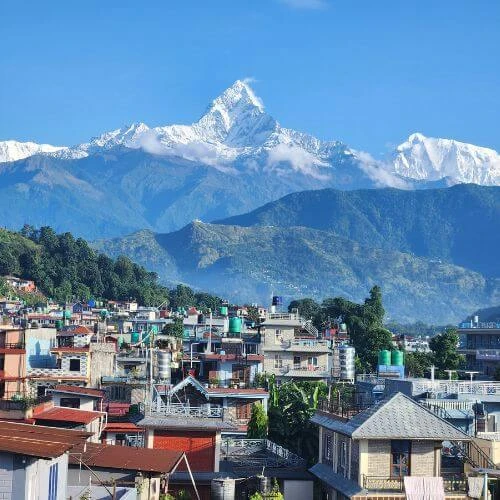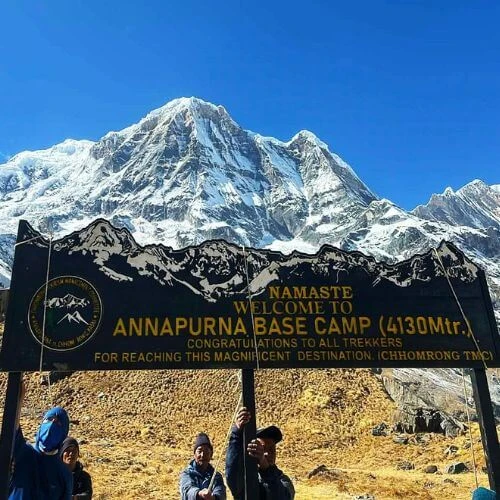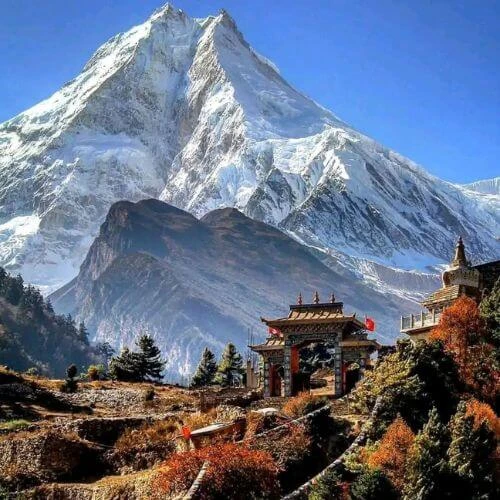Nepal, nestled in the heart of the Himalayas is a heaven for all which includes old-age hiking and trekking and proves that: age is just a number. The diverse landscapes, rich cultural diversity, and legendary peaks make trekking in Nepal an unparalleled experience. It's not only about the beautiful views; but also about diving into the vibrant blend of Nepalese culture, meeting the locals, staying in comfortable teahouses, and feeling the warm hospitality. Trekking in Nepal possess challenges like high altitude, unpredictable weather, and rugged terrains. Each step you take, whether it's a stroll through lush valleys or a tough ascent up icy peaks, trekking offers you adventure, stunning scenery, and a deep dive into the local culture.

Regardless of age, from young children to seniors, Nepal caters to trekkers of all levels. There are trails suited to everyone, from the short and scenic Poon Hill trek to the legendary Everest Base Camp trek. The Annapurna Circuit, with its diverse landscapes and traditional villages, is a popular choice, while the remote Dolpo region offers solitude in untouched wilderness.
Older trekkers find the journey appealing not just because trekking in Nepal is physically challenging but also because of the opportunity to experience the perfect blend of nature and culture. Along the trails, they discover remote villages where ancient traditions are carefully preserved. The warm hospitality of local communities, especially the Sherpas in the Everest region, leaves a heartwarming impression on older trekkers, creating a special bond among individuals who share a love for exploration and an appreciation of life's rich diversity.
In Nepal, trekking has no age limits. Older individuals, some trekking even in their 70s, understand their capabilities, proving that age is never an issue. Nepal's trekking trails welcome explorers of all ages, and with careful planning, senior trekkers can start on unforgettable adventures, immersing themselves in breathtaking landscapes and rich culture.
Instead of solely focusing on someone's age, it's more important to consider their health and fitness level and adjust the risk and precautions for elderly trekkers accordingly. Many older adults maintain excellent physical health through regular exercise, healthy lifestyles, and proactive healthcare, which are crucial factors in determining one's ability to take part in activities like trekking. The desire for adventure and exploration doesn't wane with age. Older individuals often possess a positive mindset, a wealth of life experiences, and the motivation to try new things. Engaging in trekking adventures allows them to set and achieve goals, fostering a sense of accomplishment and well-being.
Trekking is not just a physical activity; it's also a social and emotional experience. It provides an opportunity for older individuals to connect with nature, share the journey with like-minded companions, and experience the mental health benefits associated with hiking and other outdoor activities. Age should never be a barrier for individuals who want to enjoy trekking adventures in Nepal. While physical fitness and health conditions may vary among older individuals, many seniors lead active and healthy lifestyles that allow them to engage in outdoor activities like trekking. It's crucial to focus on overall well-being, including maintaining a good level of fitness, flexibility, and strength.
What are the risks and precautions for elderly trekkers?
Starting on a trek in Nepal is an incredible adventure and age should never stand in the way of turning this dream into reality. While many treks cater to experienced hikers, there are plenty of options for older trekkers who prefer a more relaxed trekking experience. As we age, our bodies may not have the same stamina, but that doesn't mean we should give up on our trekking dream. Acknowledging our limits and choosing a trek that matches our fitness level is crucial.

When planning a trek for seniors in Nepal, the focus is on comfort and accessibility. Select accommodations that meet their needs, hire experienced local guides, and consider dietary and mobility requirements for meals and transportation. Make sure the trek includes travel insurance and medical support for safety. In remote areas, medical facilities are limited, so in case of emergencies, the first aid provided by companions becomes a shared responsibility that can make a crucial difference between survival and more severe consequences.
Trekking is a wonderful experience for older adults, offering exercise, fresh air, and beautiful scenery. However, it is important to be aware of potential risks, especially for those with pre-existing conditions or less physical fitness. Addressing these risks with proper planning, support, and awareness allows older trekkers to enjoy the beauty of Nepal safely and comfortably.
Key Risks Associated with Older Trekkers While Trekking in Nepal
Altitude sickness
Altitude sickness is a serious condition that can occur when you go up to high places too quickly. Symptoms include a headache, dizziness, nausea, vomiting, and having trouble breathing. To reduce the risk of altitude sickness, it's important to ascend slowly and give your body time to get used to the higher altitude. If you're planning to trek at high altitudes (above 8,000 feet), take a day or two to get used to the conditions before starting. Drink lots of fluids and try not to do too much strenuous activity to help your body adjust better.

The risk of fall
It might sound a bit funny, but the first thing to be careful about is falling! Falling is a common risk while trekking in Nepal, especially for older adults, as paths can be uneven and slippery surfaces. It is important to wear strong shoes with good grip and use trekking poles for balance and support. If you're not cautious while walking or if your shoes lack grip, falling and getting hurt, even severely, can be a significant problem. Injuries to the wrist, hip, back, or spraining your leg are potential risks. When trekking on snowy or muddy terrain, there's a high chance of sliding and hitting a rock or boulder. So, stay alert, invest in good shoes with excellent grip, and consider using micro spikes when trekking on snow for added safety.
Snow Blindness
When trekking on snowy terrain, not protecting your eyes can lead to a condition called snow blindness. The sunlight bouncing off the fresh snow is bright and can harm your eyes, especially in the mountains where the sun's rays are stronger. Higher altitudes mean more exposure to harmful UV rays, and the snow reflects these rays, making the risk of snow blindness higher. If you spend a long time in snowy places without proper eye protection like sunglasses or goggles, it increases the chances of getting snow blindness. So, it's crucial to always wear shades when trekking on snowy paths during daylight.
Heart problems
Trekking can strain the heart, especially at high altitudes, where the air is relatively thinner. For older trekkers with heart issues, it's important to check with your doctor before going on a trek and ensure you carry any necessary medications. The heart has to work harder in thin air, which might lead to complications like a heart attack, stroke, or altitude sickness for those with heart problems. Older trekkers face additional risks due to conditions like high blood pressure, diabetes, and chronic obstructive pulmonary disease (COPD). Being less physically fit than younger trekkers can also make them vulnerable to altitude sickness and other health issues.
Other medical conditions
Older trekkers with other medical conditions, such as diabetes or respiratory problems, should also talk to their doctor before trekking.
Tips for safe trekking for older trekkers
Choose the right trek
Choosing the right trek is crucial, especially for older trekkers. Start by being honest about your abilities and ask for advice from experts like travel agents or trekking companies. Before anything else, check with your doctor to make sure you're physically fit for the trek and discuss any health concerns. Next, think about the fitness. Pick a trek that matches your physical condition and experience. It's a good idea to go for treks at lower altitudes (below 3,000 meters) to reduce the risk of altitude-related issues. Consider the duration of the trek. Shorter treks are often better for older trekkers, allowing them to enjoy the experience without pushing themselves too hard. Also, look at the type of terrain – go for treks with gentle slopes and well-maintained trails to make the journey more comfortable. Steep ascents or descents can be tough for older hikers.

Start training early
Get ready for your trek by starting your training a few months ahead, even if you're already in good shape. Start your training 4-6 months before your trek to give yourself plenty of time for safe and steady conditions. Start with activities like walking, swimming, or cycling – around 30 minutes most days of the week is perfect. As you go along, gradually increase how long and how intense your exercises are. You can extend your walking times, tackle inclines, or even add some faster intervals. Just pay attention to how your body feels and don’t push yourself too hard. Focus on boosting your cardiovascular exercises, which is crucial for long hikes at higher altitudes. Regular aerobic exercises like walking or swimming will make your heart and lungs stronger, helping you enjoy your trek even more.
Acclimatization and altitude sickness prevention
Make sure to adapt to the high altitudes in Nepal properly to avoid altitude sickness which is a serious concern. Gradually climb higher over several days and limit your daily elevation gain to about 300-400 meters, especially in the beginning part of your trek. Always have a first aid kit and purify your water with iodine/chlorine tablets. Don't forget Diamox for high altitudes. Plan rest days at specific points to let your body adjust to lower oxygen levels. Keep a close eye on how you feel – headaches, nausea, or dizziness might be signs of altitude sickness. If you experience these symptoms, descend to a lower altitude immediately and take a break.

For older trekkers, stay well-hydrated by drinking 3-4 liters of water daily, even if you don't feel thirsty. Eat small, frequent meals with carbohydrates and electrolytes, avoiding heavy meals and too much alcohol. Keep warm by dressing in layers, even at lower altitudes, and make sure you get 7-8 hours of quality sleep each night. If necessary, consult your doctor about medications like Diamox, but only under medical supervision. These are the important acclimatization tips for senior trekkers in the Himalayas.
Bring the right gear
Make sure you have the right gear for your trek – sturdy boots, warm clothes, and rain gear are essential. For older trekkers, it's crucial to prioritize comfort and safety. Go for mid-ankled, well-worn hiking boots to avoid blisters. Wear clothes made of materials like merino wool or synthetic fabrics that pull moisture away from your body. Avoid wearing cotton because it doesn't keep you as warm or dry. Pack fleece or down jackets for insulation and a waterproof trekking jacket and pants to tackle unpredictable mountain weather. Choose lightweight, quick-drying hiking pants and socks designed for trekking. Consider using trekking poles, which can help you stay steady, especially if you're an older trekker. They provide extra support and make walking on uneven terrain easier.Equip yourself with a comfortable daypack, a sleeping bag suitable for the trek's conditions, and an inflatable sleeping pad. Essential gears for older trekkers also include a warm beanie, gloves, high-quality sunglasses, sunscreen, a headlamp, and a basic first-aid kit.
Carry First-Aid Kit
For older hikers exploring the mountains of Nepal, it's crucial to carry a well-prepared first-aid kit and necessary medications. This is especially important because as we age, our bodies may face challenges like reduced balance, muscle strength, and immune response, making us more prone to falls, sprains, and infections. Adjusting to higher altitudes becomes trickier, increasing the risk of altitude sickness symptoms such as headaches and nausea.
Having a comprehensive first-aid kit is essential to promptly address minor injuries, blisters, headaches, or stomach issues before they become major concerns. This self-reliance in handling small issues can be crucial in remote locations. Make sure your first-aid kit includes items like bandages, antiseptic wipes, pain relievers, and over-the-counter medications tailored to your individual needs including diamox and aspirin. Before your trek, consult a doctor for a checkup, vaccination updates, and advice on managing chronic conditions. Inform your guide about your medical history and the contents of your first-aid kit, and learn basic first-aid skills before setting out. Prioritize essential supplies while keeping your backpack weight manageable for a smoother trek.
Consulting with a physician
Before trekking in Nepal, it's important for everyone, especially older adults, to consult with a doctor. The doctor will check out your health and fitness, making sure your heart, lungs, and muscles are up for the trek. They'll spot any potential issues and help you get ready for the challenges. If you're a bit older or have existing health problems, the doctor can talk about the risks and suggest changes to keep you safe. They'll give you personalized advice on dealing with high altitudes, recommend any medicines you might need, and make sure you're good to go. They'll also cover vaccinations, making sure you're protected from things like COVID-19 and typhoid. Talking openly with the doctor helps you make informed choices, so you can trek confidently, knowing you're all set and good to go.
Trekking with a buddy
Trekking with a friend in Nepal, especially with the help of a guide, is a fantastic way to build strong friendships. Your buddy and guide provide important safety benefits, such as immediate help in emergencies, and increased awareness of potential risks. Enjoyment is heightened through shared experiences, mutual motivation during tough times, and the opportunity to explore common interests. Additionally, having a guide brings extra advantages like local expertise for safe navigation, cultural insights, language support, and logistical assistance, making your trek more enjoyable and stress-free.

What are the best trekking routes in Nepal for elder trekkers?
Older trekkers need to choose treks that suit their fitness and experience levels, ensuring safety and enjoyment. This reduces the risk of injuries and altitude sickness, making the trek more pleasant. When the trek aligns with their abilities, it boosts confidence and fosters a sense of accomplishment. This not only benefits the trekkers but also keeps emergency services available and supports responsible tourism. In Nepal, there is a variety of treks catering to all ages and fitness levels, including gentle ascents, manageable altitudes, and comfortable accommodations. Several easy treks like Ghorepani Poon Hill Trek, Langtang Valley Trek, Nagarkot Day Hike, Champadevi Day Hike, Pikey Peak Trek, Manaslu Circuit Trek, and Khumai Dadha Trek are perfect for older hikers looking to appreciate the beauty of nature.
Ghorepani Poon Hill trek is a perfect example of an easy trek suitable for older hikers. Here is a short itinerary:
1. Arrival in Kathmandu:
- Start your journey by arriving in Kathmandu.
2. Drive from Kathmandu to Pokhara:
- Enjoy a scenic drive from Kathmandu to Pokhara.
3. Drive from Nayapul and Trek to Tikhedhunga:
- Begin your trek with a drive to Nayapul and then trek to Tikhedhunga, starting at an elevation of 1480 meters.
4. Tikhedhunga to Ghorepani Trek:
- Continue your trek from Tikhedhunga to Ghorepani.
5. Morning Hike to Poon Hill and Trek to Tadapani
- Experience a morning hike to the stunning Poon Hill at an altitude of 3210 meters, and then trek to Tadapani at 2630 meters.
6. Trek from Tadapani to Ghandruk
- Trek to the charming village of Ghandruk, situated at an altitude of 1950 meters.
7. Ghandruk-Nayapul-Pokhara:
- Complete your trek by heading from Ghandruk to Nayapul and then drive back to the beautiful city of Pokhara.
This trekking route offers a wonderful mix of nature, culture, and moderate physical activity, making it suitable for older hikers who want to enjoy the scenic landscapes at a comfortable pace.
Ghorepani Poonhill Trek itinerary
Conclusion
In the world of trekking, older adventurers are breaking stereotypes and proving that age is just a number guided by their determination for adventure, strong dedication, and thorough planning, these hikers enthusiastically navigate challenging landscapes. Despite the changes in their bodies, they adapt by choosing suitable trails, working hard to stay fit, and taking good care of themselves. With the right gear and a good plan, these hikers not only see amazing views but also make friends and enjoy the thrill of challenging themselves. Old-age hikers give an example that one's age should never limit the spirit of adventure. With the right mindset and preparation, anyone can embrace the thrill of exploration.
Adventure has no limits, and age shouldn't hold you back. Look around, and you'll find many people, full of life experience and stories, conquering trails and reaching mountain tops. Remember, trekking is a journey, not a race. Choose trails that match your speed, enjoy the scenery, and listen to your body. Preparation is important, but don't overthink it. Consider joining a group or finding a trekking buddy for the company. Adapt to your body's changes, celebrate every trek as a victory, and embrace the adventure!










